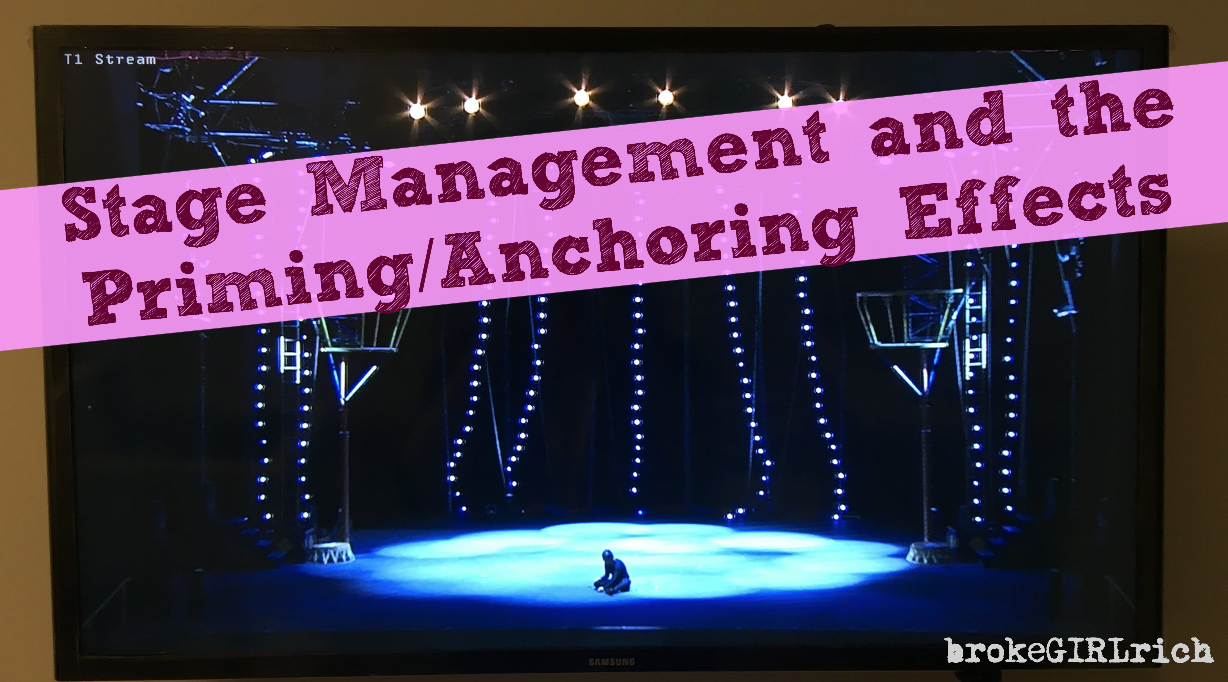
Stage Management and the Priming/Anchoring Effects | brokeGIRLrich
Today’s post is all stage management, friends, sorry, we’ll be back to our regularly scheduled personal finance and sometimes moaning about life shortly.
So my day job does a lot with apply cognitive behavioral science to selling techniques and a book that gets mentioned a lot at work is Thinking Fast and Slow by Daniel Kahneman.
After several weeks of hearing the book mentioned, I decided I wanted to read it. It’s a pretty fantastic book, though it’s definitely not light reading. To combat the mental fatigue, I’ve just been plodding through a chapter at a time.
The last two chapters though were about anchoring and priming and as I read them I realized good stage managers are masters of these techniques even though no one ever explicitly taught them to me.
First, let me back up and define them for you.
Priming is when exposure to one stimulus influences how a person responds to another stimulus. It’s often done using a word or picture.
Anchoring is a bias where people rely on pre-existing information when making a decision.
Here is a great example of how stage managers use priming – most stage managers greet you pleasantly and with a smile. Also, when things get tense, most stage managers know they need to maintain a calm and pleasant demeanor. Facial expressions are major primers for whatever words are coming next.
They are priming you to react in the same way.
Another priming example is when you use comics or upbeat clip art or anything visual on the signs and paperwork you create that is intended to evoke a feeling or a positive reaction to the information being absorbed.
It’s even as silly as putting a joke of the day on the sign in sheet that makes people start their day with a smile (and hopefully remember to sign in). You’re priming folks for a good day at work.
Years ago when I worked on ships, we had to do these safety toolbox discussions each week that no one really loved doing. When we would get to the quiz at the end, the person who answered the question right would get a piece of candy. After the first week, everyone knew that if they paid attention and answered the questions, they could get candy. Priming.
When you review the goals of the day before embarking on them, that’s a method of priming too.
If anyone has ever told you to strike a power pose before going into an interview or negotiation – or tech week – that’s an example of priming.
Moving on to anchoring, this past week at the Connection Convention, I was listening to the walk from the folks who have pivoted into being Covid Compliance Officers on movie sets. One of the women gave a fantastic example of anchoring.
Because the set protocols don’t call for double masking, she can’t tell people to double mask. However, as she hands them their new mask for the day, she politely tells them they could certainly use it with their current mask, if they want. She anchors them in that idea.
Some people still choose to reject it, but just by carefully selecting her words, she can encourage a lot of folks to do the activity she’s hoping they’ll do.
Anchoring also happens when you look at salaries for jobs (ah! Here’s something about money). When you see that number, you have a good idea of that range you might negotiate. If you see a job offering $300/week and want $1500/week… you know it’s probably not worth it to apply. If you see the same job but you could make $400/week a work, it could still be worth applying and trying to negotiate.
Anchoring bias can also be used against a little as stage managers. I think of times when I’m making a complicated schedule and honestly, when all other things are equal, sometimes the person who complained the loudest or last is likely to get the extra time I can find – whether or not that’s the ideal way to set up the schedule. They were able to anchor their argument.
Similarly, you might know that you have 4 hours planned for lights on the schedule on this particular day of tech, but the first time you review the production schedule with everyone, the light designer balks and insists on at least 12. There’s no way to do it in less than 12.
Will they do it in less than 12? Probably. But is it now going to be a lot more than 4 – also probably. When they threw out that number 12, it became the anchor that you have to start working with though (after many questions like why do you need three times the normal light time when I clearly haven’t flagged anything before now to justify that?).
This is so fascinating to me, because I think a lot of good stage management comes down to how you’re anchoring and priming the people you work with, and also how to keep anchoring bias from derailing you sometimes too.
If this has been interesting to you, you can check out Thinking Fast and Slow by Daniel Kahneman, it’s all about how people use two systems in their thinking – System 1 (instinct, knee-jerk reactions) and System 2 (analytical thinking) – and different things that can influence these systems.




Pingback: The Starving Artist Anchor Effect - brokeGIRLrich